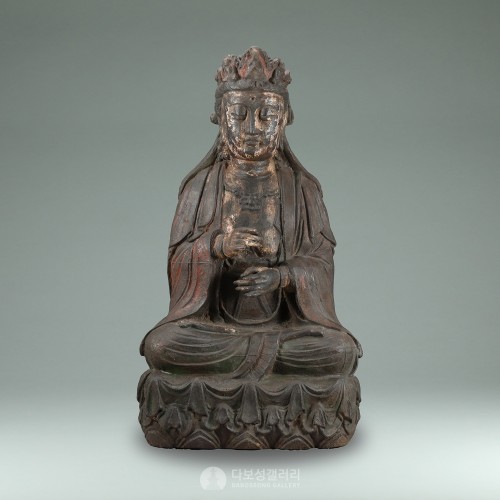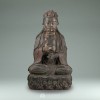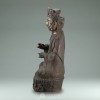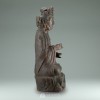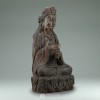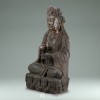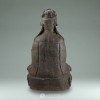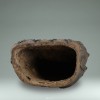본문
명나라 천계(天啓) 7년(1627) 음력 10월에 제작된 이 관음보살(觀音菩薩) 좌상은 높이 64.5cm의 비교적 큰 철불로 금으로 도금한 흔적이 여러 군데 남아 있어 세월의 흔적이 느껴집니다.
크기가 크고 다른 보살상에 비해 단순하면서도 높고 아름다운 보관을 갖춘 특징이 있습니다.
머리에는 서방 정토의 부처인 아미타불(阿彌陀佛)의 모습이 새겨진 보관을 갖추었고 가슴 위에는 연꽃 문양이 양각되어 있어, 외관상 중생을 제도(濟度)하는 관음보살임을 알 수 있습니다.
보살상 등 뒤에는 제작한 날짜와 함께 비와 바람이 순조롭게 내려 백성이 부유하고 나라가 강대해지기를 기원하는 뜻의 ‘기보풍조우순 국태민안 (祈保風調雨順 國泰民安)’ 글씨가 양각되어 있습니다.
'풍조우순(風調雨順)'은 바람과 비가 순조롭게 분다, 기후가 순조로워 곡식이 잘 된다, 천하가 태평하다 등을 뜻하며, 이 문장은 중국 주(周)나라 유명한 낚시꾼인 강태공(BC1211~BC1072)이 쓴 『육도(六韜)』에서 '(주나라가) 은나라를 이기니 풍조우순했다’는 뜻의 旣而克殷 風調雨順 (기이극은 풍조우순)에서 유래하였습니다.
이후 후진(後晋)의 역사가인 유후(劉昫, 887~946)도 『구당서(舊唐書)』를 지으면서 이 말을 인용하여 '정관의 치(貞觀之治, 당 태종의 태평성대 시기) 이래 22년간 풍조우순하고 해를 이어 풍년이 들었다(自貞觀以來 二十二年載 風調雨順 年登歲稔)'라고 썼습니다.
■ 불상 등 뒤의 명문
龍飛天啓七年 孟冬吉旦造 祈保風調雨順 國泰民安
성스러운 황제 천계제 7년(1627) 음력 10월 1일 비바람이 순조롭게 불어 나라가 태평하고 백성이 편안하다.
━━━━━
明代天启7年阴历10月铸造的观音菩萨坐像。
该坐像高64.5cm,相对是一尊比较大的铁佛像,有几处还留有镀金的痕迹,可以感受到岁月的痕迹。
最重要的是,与其他菩萨像相比,它的特征是非常大的尺寸和简单而高大的存储空间。
头戴刻有西方净土阿弥陀佛像的宝冠,胸前浮雕莲花纹,可以知道是普度众生的观世音菩萨。
佛像背后阳刻制造日期和铭文,“龍飛天啓七年 孟冬吉旦造”,意为作于明熹宗七年,阴历十月一日。
“祈保風調雨順”即“指风雨及时适量,有利于农业生产。
“风调雨顺”指风雨适合农时,年景好。
此成语出自周朝有名的钓鱼者姜太公所写的《六韬》中“既而克殷,风调雨顺”。
后晋历史学家刘昫在《旧唐书》中引用了该句,“自貞觀以來 二十二年載 風調雨順 年登歲稔。”
* 佛像背后的铭文:龍飛天啓七年 孟冬吉旦造 祈保風調雨順 国泰民安
━━━━━
A seated statue of Guanyin Bodhisattva cast in October of the lunar calendar in the 7th year of Tianqi in the Ming Dynasty.
The seated statue is 64.5cm high, a relatively large iron Buddha statue, and there are still traces of gold inlays in places, which can feel the traces of time.
Most importantly, it is characterized by an enormous size and a simple and tall storage space compared to other Bodhisattva statues.
A crown engraved with the image of Amitabha Buddha in the Western Pure Land and a lotus pattern embossed on the chest imply that it is Avalokitesvara Bodhisattva who saves all living beings.
The production date and script are engraved on the back of the Buddha statue. The script wishes for a timely and appropriate amount of wind and rain that is conducive to agricultural production.
Fengdiao Yushun (風調雨順) means that the wind and rain are suitable for farming and the year is good.
This idiom comes from the "Six Secret Teachings" written by Jiang Taigong, a famous fisherman in the Zhou Dynasty.
Later Jin historian Liu Yan quoted this sentence in the "Old Book of Tang," "22 years since Zhenguan, the weather has been good, and has had a good harvest every year."
■ The inscription on the back of the Buddha statue
龍飛天啓七年 孟冬吉旦造 祈保風調雨順 國泰民安
On October first of the lunar calendar in the seventh year of the Holy Tianqi era (1627), pray for good weather, peace, and prosperity for the country and the people
